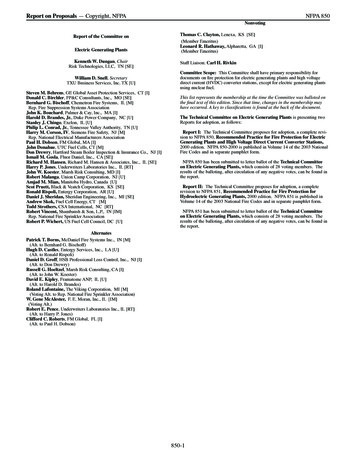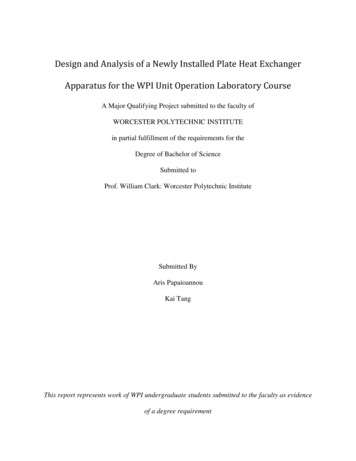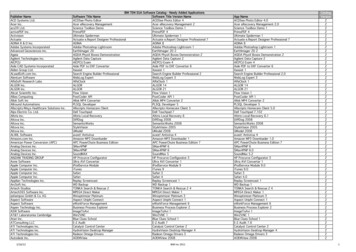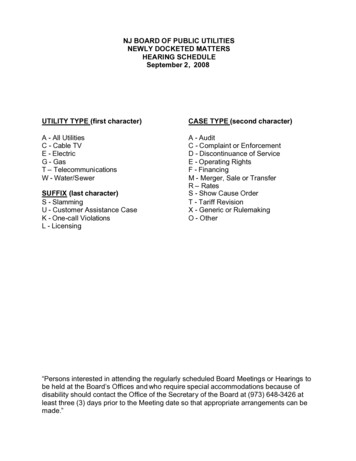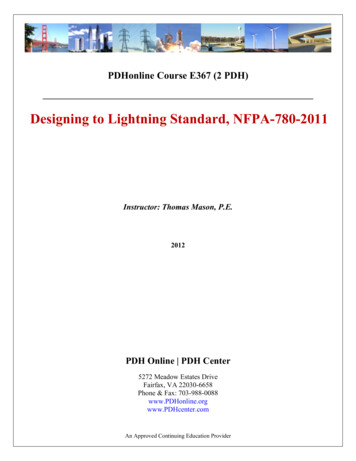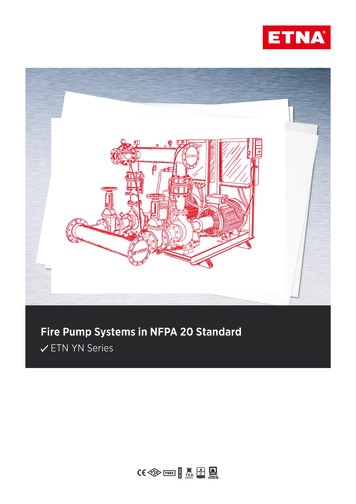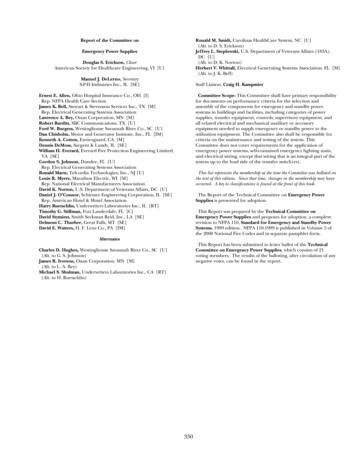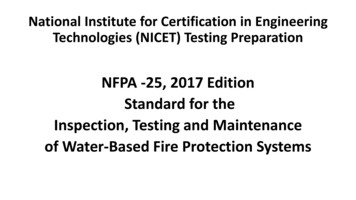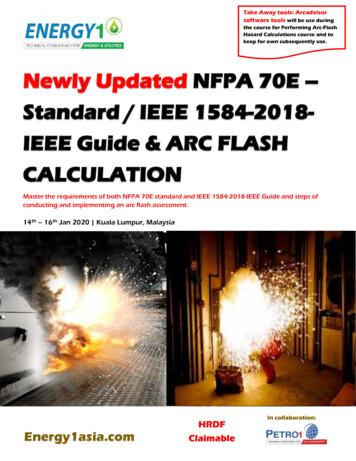
Transcription
Take Away tools: Arcadvisorsoftware tools will be use duringthe course for Performing Arc-FlashHazard Calculations course and tokeep for own subsequently use.Newly Updated NFPA 70E –Standard / IEEE 1584-2018IEEE Guide & ARC FLASHCALCULATIONMaster the requirements of both NFPA 70E standard and IEEE 1584-2018-IEEE Guide and steps ofconducting and implementing an arc flash assessment.14th – 16th Jan 2020 Kuala Lumpur, MalaysiaEnergy1asia.comHRDFClaimableIn collaboration:
NFPA 70E –Standard / IEEE 1584-2018-IEEE Guide & ARC FLASH CALCULATIONThis 3-day masterclass will review all of the significant changes to both NFPA 70E-Standard for Electrical Safety inthe Workplace and IEEE 1584-2018-IEEE Guide for Performing Arc-Flash Hazard Calculations.qArc Advisor: (Each participant will be receiving Arcadvisor software tools F.O.C to use during the course and to keep forown subsequently use)Participants will be given worksheets with a sample one-line diagrams with the information needed to perform short circuitcurrent calculations. This will provide participant with hands-on experience on determine incident energy, arc flashprotection boundaries and complete the arc flash warning label for each location by using the Arcadvisor software. Theywill also select the proper PPE required to protect exposed workers.Will this course benefit company that are currently have an existing software such as ETAP, SKM or Easy Power?There are major changes to IEEE 1584. The changes include equations for 5 different electrode configurations, choices forenclosure sizes, an enclosure correction factor calculation to adjust for enclosure sizes, and the grounded vs. ungroundeddifference has been eliminated. Those that are currently using commercially available software for performing arc flashhazard analysis will need to be aware of these major changes in the calculations. Participants will also learn how toproperly obtain the necessary data based on the latest requirements to accurately represent the system under study.MASTER the necessary knowledge and complexities of: Define arc flash assessment methodsHow to choose between the table method and the calculation method of arc flash hazards assessmentIdentify when to use single phase vs three phase calculationsUnderstand changes to IEEE 1584When to use ArcPro (utility) Vs IEEE 1584 (utilization)Requirements of NFPA 70E (2018)Arc flash clothing requirementsCalculation methods (hand calculations or commercial software)Limiting arc exposure / Training requirements for exposed employeesThe trainer will answer important questions regarding arc flash hazard assessment, including, but not limited to: What regulations require arc flash assessment? What methods are available to perform arc flash hazard analysis? / Are all my employees exposed? What type of work exposes an employee to a reasonable likelihood that an arc flash could occur? Should I use the table method or calculation method? After the assessment, what clothing is required? What information is required to given to my contractors? / Are my work practices compliant? What are the circumstances for performing energized work? Do I need a work permit for all electrical work? What is “normal operation” of equipment? / Can employees work alone? What is the difference between a shock and an arc boundary? Are arc flash labels required? What information is required to be on themThis program is intended for:Any industrial and manufacturing that have employees that service and maintain electrical equipment whileenergized should attend this course: Plant, facility, and electrical engineersConsulting, utility and industrial engineers responsible for arc hazard analysis in the selection of protectiveequipment and clothingSafety officers and program managersUtility Engineers needing in-depth understanding of arc hazard assessment and analysisEngineers that are currently using commercially available software (ETAP or Easy power) for performing arc flashhazard analysis will need to be aware of the major changes in the calculations. (Due to major changes to IEEE 1584)The NFPA 70E requires employees working on or near energized equipment of 50 volts or more be NFPA70E Arc Flash trained, this includes anyone who is:oInstalling/Maintaining Electrical Equipment / Maintaining Plant or Facility Lighting Installing/Replacing Motors/ AdjustingMotor Overloads / Replacing Fuses / Repairing Motor Controls / Installing/Maintaining HVAC Equipment / Working on Plantor Building Generators / Troubleshooting Plant or Building Electrical Problems / Managing or Supervising MaintenanceOperations, etc.
NFPA 70E –Standard / IEEE 1584-2018-IEEE Guide & ARC FLASH CALCULATIONDAY 1Hazard of electricityShock Identifying Shock hazards – How they occurCurrent level that will cause various reactions and effect to thehuman body.Understand shock magnitude scales.Arc How the arc is developedEffects of the arc on bare exposed skinRequired PPE for protection from the arcBoundaries Shock Boundaries (at various voltage levels) – Limited —What itis and who can cross it -- RestrictedFlash BoundariesoHow to determine the Arc Flash boundary with engineeringlabelsoUsing the tables in NFPA 70EoMethods for reducing the Flash boundaryoWho can be within an Arc Flash Boundary?Selection and Use of Safe Work Practices The options required by the employer to protect the workerWhen can equipment be worked on hotImplementing an Energized Electrical Work PermitWhat is an Electrical Safe Work condition?How to establish a Safe Work Condition through LO/TOVerification of the absence of voltageUse of locks and tagsAuthorized Person vs. Qualified PersonConductive Objects and AppareloClearance distances to overhead or exposed conductorsoConductive objects near overhead conductorsoSafe handling of conductive objects in the workplaceInterlocks What are they and who can defeat them and when?DAY 2Test Instruments and Tools Who can use a test instrument?Latest standards and ratings of test instrumentsWhat is Cat RatingTraining requirements for test instrumentsProper use and care of test instrumentsSelection of Shock Protection Rubber glove identification, use, care and storageSizing for rubber gloves Testing requirementsSelection of Arc Flash Personal Protective Equipment How is flash protection rated?Using the simplified clothing methodUsing the protective clothing matrixUse and care of arc rated clothingDAY 3The Arc Flash Calculation Study Using IEEE Std. 1584 Study requirements, methodology, calculation standards, qualificationsand methodsData Collection ProcessTransformer, conductor, utility company, motor, overcurrent device,equipment type, working distance, generator dataSingle Line Diagram and System ModelingImportance of the up-to-date diagram, system configurations, high vs.low fault current, 125 kva transformer exception, motor contributionArcing Current CalculationsArcing current calculations, defining the arc gap based on equipmenttypeArc Flash Duration - Time Current CurvesDetermining the arcing current clearing time, 85% vs. 100%, 2 secondcut off rule, time current curves, arc extinctionIncident Energy CalculationsIncident energy calculations, calculation parameters, calculation factor,distance exponent, working distanceArc Flash Boundary CalculationsArc flash boundary calculations based on normalized incident energy,detailed IEEE calculations, unusually large boundaries, calculationworksheets, problem solvingDetermining PPE Requirements from Incident EnergyCalculationsUsing calculated incident energy to determine PPE requirements.Comparing calculations to NFPA 70E tables, simplifying the selectionArc Flash Warning LabelsRequirements, Label LocationsVoltage Rated Tools and EquipmentRecommendations to Reduce the Arc Flash Hazard Increase working distance, remote operation, maintenance settings, arcresistant equipment and current limiting devices How to recognize an insulated tool by marking andidentificationWhen they need to be replacedWhere they must be used and by whomWhen are hot sticks required?Risk Categories Tables What are risk categoriesReading and understanding the information on engineeringlabelsEngineering Studies vs. Risk Categories Tables from NFPA 70EWarning labels onlySelection, Use and Care of Personal Protective Equipment (PPE)PRACTICAL INVOLVEMENT:Having the ability to implement directly once you are back at yourworkplace is crucial for every participant. During the 3 daystraining, practical involvement and activity will be share. Participantwill be involved in activities as per below: Data collection exerciseArc flash calculation exerciseLabel development exercisePPE selection exercise
NFPA 70E –Standard / IEEE 1584-2018-IEEE Guide & ARC FLASH CALCULATIONCASE STUDIES:Several case studies of serious arc flash incidents. Each case study has photos of the results of improperlyassessing the arc flash hazards and not utilizing proper PPE. The class will also see many video examples ofthe same.The course is delivered as a combination of lectures, tuturiols, exercises and discussion. Participant will haveample opportunity to disucss their own issues. Each participant will receive arcadvisor software tools to useduring the course and to keep for own subsequently use.Laptop is requiredPast clients Testimonials“"EXCELLENT! ARC FLASH ASSESSMENT /CALCULATION”Hengyuan Refining Malaysia“THE USE OF SOFTWARE TO CALCULATE THE ARCFLASH”.Tenaga Nasional Berhad"CALCULATING THE ARC ENERGY, PPE. GOOD.ENJOYED IT!! “Sarawak Shell Berhad“HANDS ON CALCULATION”. KNOWLEDGEABLE,PRACTICAL, WELL VERSED IN THE SUBJECT OF ARC FLASH.”Sabah Shell Petroleum“SIMPLE , SMOOTH ! EASY TO FOLLOW.”Tenaga Nasional Berhad“INSTRUCTOR VERY EXPERIEINCED &KNOWLEDGEABLE. CONCEPTS WERE CLEARLYEXPLAINED!.”Berakas PowerInterested in bringing a course to your location? Do you have 10 or more people needing training?We would love to help! Call us at 603 7727 3952 or email ihtraining@petro1.com.my to discuss special pricing andinformation.
NFPA 70E –Standard / IEEE 1584-2018-IEEE Guide & ARC FLASHCALCULATION (3 Days)Registration FormNewly Updated NFPA70E - Standard & ARCFLASH CALCULATION3 or moreparticipantsPerParticipantFull 3 DaysSGD 3199 ( )SGD 3499 ( )REGISTER 3 AND SENT THE 4TH FREE Please note that all registrations must be made at the same time to qualify.The above investment fee is inclusive of course material, tea breaks and lunch.The above investment fee is excluding of SST 6%.PROGRAM DETAILSVenue: Kuala Lumpur, MalaysiaDate: 15th – 17th Jan 2020REGISTER NOWCONTACT: KelvinMAIN: 603 7727 3952FAX: 603 7727 5278Email: registration@petro1.com.my( ) I would like to organize this training on-site and save at least 25% on the total course Fees! Please call 603 7727 3952 for more aboutour in-house training or email ihtraining@petro1.com.my (Terms & Conditions apply)Delegates Details1. Name: Mr Mrs Ms Dr Credit card PaymentPlease Debit my credit card: VISAJob Title: MASTERCARDEmail :Card Number: - - -Contact No:Security Code:Department:Named printed on card:Expiry Date:2.Name: Mr Mrs Ms Dr Job Title:Signature:Email :Payment MethodBy Direct Transfer: Please quote invoice numbers on remittance advice.Contact No:ACCOUNT NAME : PETRO1 SDN BHDBANK : United Overseas Bank (Malaysia) BHDACCOUNT NO : 202 900 3191 (SGD)All bank charges to be borne by payers. Please ensure that PETRO1SDN BHD received the full invoice amount.** Credit card payment will include a charge 2.8%Department:3.Name: Mr Mrs Ms Dr Job Title:Email :Contact No:Department:Head of Department:Invoice DetailsInvoice Attention to:Company:Industry:Address:Postcode: Country:Telephone: Fax:Email:AuthorizedSignaturePayment Policy: Upon receipt of a completed registration form, it confirms that theorganization is registering for the seat(s) of the participant(s) to attend the conferenceor training workshop. Payment is required with registration and must be receivedprior to the event to guarantee the seat. Payment has to be received 7 working daysprior to the event date to confirm registration.Sales and service Tax (SST):The above investment fee is excluding of SST 6%. The SST charges of 6%will be include during issuance of the invoices.Venue: All of our training courses are held in 4 – 5-star venues.The course fee does not include accommodation or travel cost. It’s recommended tobook the hotel room early as there are only limited room available at the discountedcorporate rate.DATA PROTECTIONThe information you provide will be safeguarded by Petro1 that may be used to keepyou informed of relevant products and services. We take it seriously when it come s toprotection of our client data.Cancellation & Substitutions:Upon receipt of a completed registration form, it confirms that the organization isregistering for the seat(s) of the participant(s) to attend the conference or trainingworkshop. Should you be unable to attend, substitutes are always welcome at noadditional cost. Please inform us as early as possible. Payment is non-refundable ifcancellation occurs 7 working days prior to event commencement. However, asubstitute is welcome at no additional charges. If cancellation occurs 5 working daysprior to the registration date and there is no substitute, the organizer reserves theright to charge 50% of the total investment from your organization.PETRO1 SDN BHD is not responsible for any loss or damage as a result of asubstitution, alteration or cancellation/postponement of an event. PETRO1 SDN BHDshall assume no liability whatsoever in the event this training course is cancelled,rescheduled or postponed due to a fortuitous event, Act of God, war, fire, labor strike,extreme weather or other emergency.Walk in Registration:Walk-in p
The Arc Flash Calculation Study Using IEEE Std. 1584 Study requirements, methodology, calculation standards, qualifications and methods Data Collection Process Transformer, conductor, utility company, motor, overcurrent device, equipment type, working distance, generator data Single Line Diagram and System Modeling Importance of the up-to-date diagram, system configurations, high vs. low .

